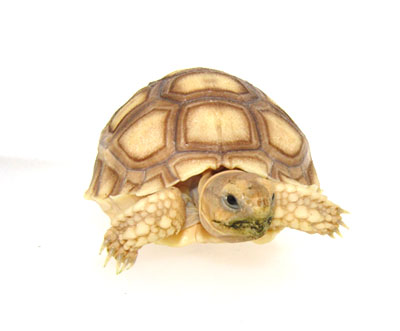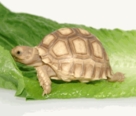One of a Kind Baby Sulcata Tortoises - Unique Extra Scutes
Medium 2" - 3"
Large 3" - 4"
XL 4" - 5"

We have baby African Spur tortoises (Geochelone Sulcata) also known as Sulcatas. These babies are well established and are the hardiest tortoises available.
Extra scutes is not genetic. It is usually caused by eggs incubated at higher temperatures. They are just as healthy and big as their normal scute brothers and sisters. There is no health risk for them later in life. A lot of people prefer extra scute babies as they have their own individualized "finger print".

Sulcata Tortoises are cute, spunky, active and eating machines. These little guys are recently hatched, have perfect hard shells and ready for good homes. These guys are just adorable and have tons of personality. Raised in California sun on grass, mazuri tortoise diet and mixed vegetables.
Adult sulcatas soon learn to recognize their owners and will follow them around the yard waiting to be given a treat, such as that rose they just couldn't reach!
HISTORY
African Spurred Tortoises (Geochelone sulcata) are the third largest species of tortoise in the world, after the Galapagos and Aldabra tortoises. Sulcata tortoises come from a dry, arid location in Africa. Adult sulcata tortoises can weigh 70 to 150 pounds, and measure 24 to 30 inches in shell length. They can live over 100 years if cared for properly and can outlive their owners. Therefore, you must consider who will care for your Sulcata when you are no longer able.
Sulcatas have broad, flattened carapaces, evenly brownish or yellowish in color. As they age, the growth rings inches on each of the scutes are strongly marked. Mature males develop reverted marginal scales in the front. The gulars on the plastron (the marginal scales just under the neck) are deeply forked; the anal scutes are also deeply divided. The skin on the legs is well blended into the shell color. Well-defined spurs, which serve no observable function, are present on the back of the rear legs. Their skin is very thick which may serve to reduce fluid loss through transpiration.
HOUSING: HEATING AND LIGHTING
Babies can be kept in a glass terrarium, minimum of 20 gallons. All tortoises living indoors will require a UV light and heat lamp. To begin with, never use a hot rock as a heat source. Hot rocks are the worst, especially for a tortoise! The very best ground heat source for all reptiles is an under-tank heater or heat pad. However, tortoises do best with basking heat from above, as it replicates the natural heat from the sun. The best tanks are fully enclosed with built-in UV light and heat lamp with sliding glass doors in front. This type will also maintain the UV and heat much better.
Two Types of Lighting will need to be turned on for 10-12 hours per day:
- 1. An incandescent light bulb should be placed on the top of the tank opposite the side with the hiding spot to provide your tortoise with a warm basking spot. Depending on the size of your tank and the temp in the room, anywhere from a 15 watt to a 75 watt bulb can be used. Place a thermometer under the bulb on the ground where your tortoise will bask and make sure the temperature reaches 95-105 degrees when the light is on. If not, adjust the wattage of the bulb accordingly. A second thermometer should be placed at the other (cool) end of tank to make sure that side is at least 10-20 degrees cooler than the basking side so you don't cook your new pet! This light should be turned off for the night. However, if your house gets colder than 72 degrees at night, a black or blue light should be used to bring the temperature up to 75-80 degrees.
- 2. Sulcata Tortoises require a florescent UVA/UVB light. This light replicates the sun's rays which radiate vitamin D3, helping the animal to absorb calcium into their body. The light needs to be placed within 8-12 inches of the tortoise basking spot in order to be effective. The light should be replaced every 6-12 months. This light should be turned off for the night as well.
- Hidding Log: A 1/2 log or other hiding spot can be placed at one end of the tank. Baby tortoises love going inside to sleep or will position themselves against the wall or a corner of their tank. In the wild, these guys burrow or dig under something to keep out of the hot sun.
SULCATA BEDDING
(Substrate) can consist of Alfalfa (rabbit) pellets, hay or aspen bark. Do not use any type of humidity holding bark such as pine or cypress, since the tortoise is unable to tolerate high humidity. Humidity from a water bowl or moist bedding can cause respiratory infections in Sulcata tortoises. Therefore, DO NOT keep a water bowl in the tank with your tortoise, unless for brief periods to take a drink. Bedding will also need changed regularly to discard moist substrate and potential mildew from urine.
SOAKING YOUR SULCATA
Some owners choose to soak their tortoises in addition to providing a water bowl and a higher-humidity sleeping area. Hatchling (less than 1 year old) tortoise can be soaked every day, since they are the most likely to become dehydrated. Juvenile tortoises (between the ages of 1 year and 5 years) should be soaked two or three times per week. If you have an adult sulcata tortoise, make sure you provide it with a very shallow pond so that it can walk into the water to drink and soak as necessary.
The water in which you soak a tortoise should be comfortably warm, but not hot. The water level should not be deeper than the base of the tortoise neck. It's best to use some sort of plastic container that you can clean thoroughly after each use. Your tortoise may poop when placed into warm water, so be prepared to change the water at least once during each soak. Soaking time can range from 5 minutes to 15 minutes. After the soak, dry the tortoise off with paper towels before you put it back into its pen or enclosure.
SULCATA DIET:
Sulcata Tortoises are strictly veggie eaters. Do not feed these guys insect or animal matter. Their digestive systems are not designed to process these types of foods. Sulcata need lots of fiber in their diet. They need to get a large variety of grasses, dark leafy greens, fruits, and vegetables to be healthy. Their diet should consist of 80-90% grasses, hays and dark greens, 10-20% vegetables and fruits. Try things like collard greens, rye grass, clover, escarole, romaine, any type of grass, red or green-leaf lettuce, cabbage, timothy hay, alfalfa hay, dandelion greens, and the pre-cut variety packs of "baby greens" available at the grocery store. A lot of people plant different grass seeds in small shallow pans and then rotate them through the tank, allowing the tortoise to graze from the growing seeds. Offer your tortoise berries, apples, peaches, beans, peas, carrots and as many different types of fruits and veggies as you can. Iceberg lettuce should NEVER be fed to any reptile. Rep-Cal Calcium and Multivitamin powder should be sprinkled over food 2-4 times per week.
OUTDOOR HOUSING
If you eventually do keep your tortoise in your yard, you want to make sure that your grass is natural, and not sprayed with any pesticides or fertilizing agents if possible. If you have a garden with fertilizer in it, you might want to fence that particular area in. You should take plans to ensure your fence is sturdy enough to withstand digging and burrowing that may take place, which may mean you need to have the fence sunk into the ground a few inches. Many people do this now for their dogs that tend to dig, so I'm sure you won't be the first to ask your local fence company to sink a fence. Also, be sure to furnish your yard with plants and grasses that are edible for the tortoises.
Additionally, you should make sure your tortoise has a shelter to use in case of inclement or cold weather. These tortoises can take light, warm rain, it is even good for them to be stimulated by their changing environment. However, the Sulcata cannot be left outside for long periods of cold, damp, rainy weather, or in the cold winters of northern areas. You can provide an insulated shed with a access ramp for shelter. You should also furnish this shed with some pig farrowing heat pads, heat lamps, UVB Light, and hays. Throw a little hay inside and you will have a very cozy and comfortable Sulcata.

Before Placing Your Order
Store InformationShipping Info
Payment Info
Return Policy
Arrive Alive Guarantee
Adoptation Policy
After Placing Your Order
Track Your OrderSecurity Safe Shopping
Compatibility Chart
Shoppers Review









